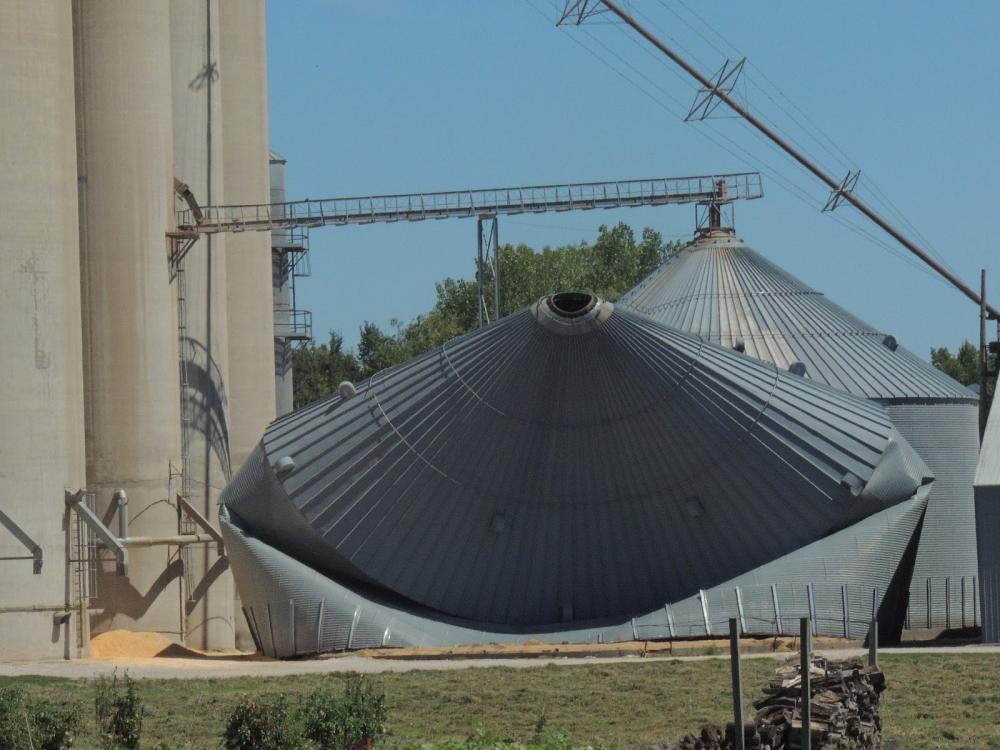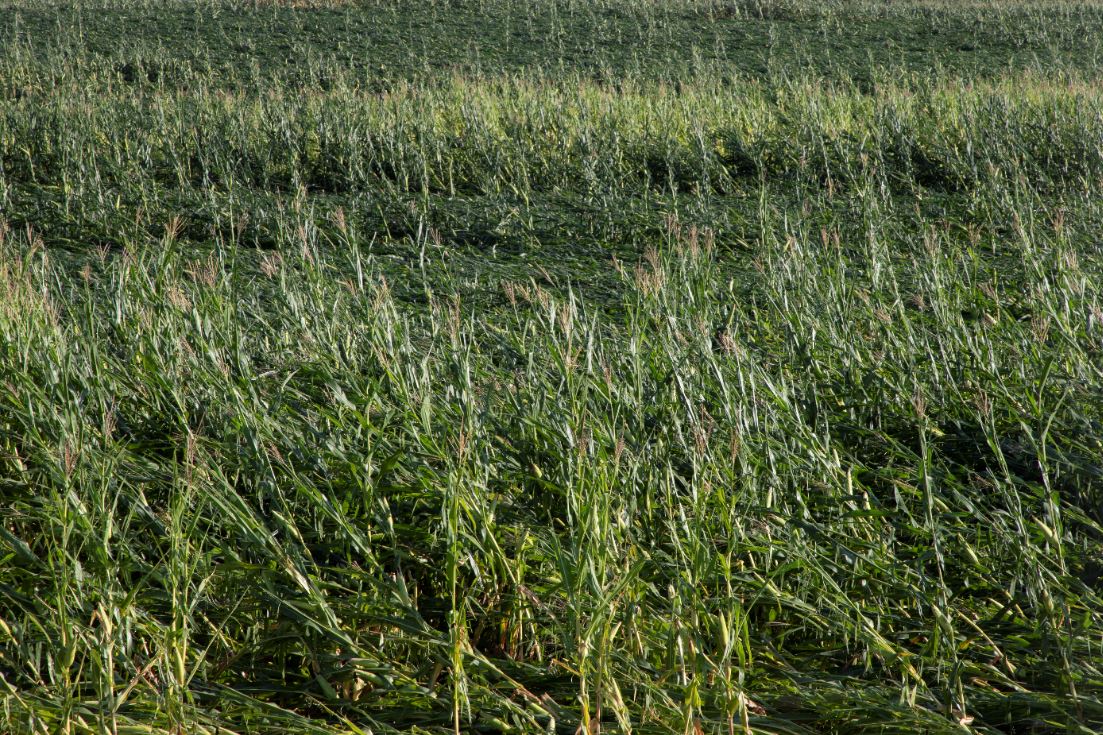Cash flow, storage may challenge farmers in shadow of destructive storm

MICHAEL CRUMB Aug 20, 2020 | 4:10 pm
5 min read time
1,203 wordsAll Latest News, Energy, Statewide NewsAbove: A Heartland Cooperative grain bin in Cambridge sits crumpled after it was damaged in last week’s storm. Photo by Michael Crumb
Below: Corn showing significant damage in rural Jasper County. Photo by Emily Blobaum
As farmers continue to assess the damage to their crops from last week’s derecho, a storm that leveled cornstalks and collapsed corn bins, attention may quickly turn to grain storage capacity as the start of fall harvest approaches.
The latest data from the U.S. Department of Agriculture shows that more than 3.5 million acres of corn and 2.5 million acres of soybeans in 36 Iowa counties were hit the hardest by the winds that topped 100 mph in many areas. In Central Iowa, wind speeds of 80 to 100 mph were common as the storm swept across the state on Aug. 10. Farther east, as the storm gained strength, winds reached speeds of 110 to 140 mph from Benton to Linn and Jones counties, the equivalent of an EF3 tornado.
For farmers already looking at reduced yields because of spreading and worsening drought conditions, the storm may have ended the growing season for much of their crop.
“When you put boots on the ground, when I go through my county, and you walk some fields, there’s a lot of fields that are 70% lost or more,” said Lance Lillibridge, who farms in Benton County. “It’s unbelievable the damage that’s in it. It’s not a good situation.”
The drought that was quickly spreading across Iowa left the crops vulnerable, making them unable to recover from the storm, said Lillibridge, a member of the Iowa Corn Growers Association’s board of directors.
“We were really dry before the storm, and because of the maturity of the corn, it didn’t stand a chance in 90-100 mph winds,” he said. “If we had an adequate amount of moisture in the ground, and that stalk had some moisture in it, it would have had a better chance of standing back up and surviving and maturing correctly. But because we’re so dry, we’re not recovering in the affected area at all. We’re continuing to go downhill. These plants are dying off left and right.”
Damage to grain storage bins may be what leaves the biggest mark from the storm as cooperatives work to repair and rebuild grain bins that were damaged or destroyed, a process that could take a year or two, experts said. As much as 60 million bushels of storage may have been lost in the storm.
Heartland Cooperative reported significant damage to 75 of its grain bins at 24 locations in Greene, Boone, Story, Marshall, Polk, Jasper, Poweshiek and Tama counties, officials with the company said. The damage represented almost 16 million bushels of storage, they said.
Heartland also sustained damage to grain dryers, conveyors, fertilizer buildings and other structures, company officials said in an update provided to the Business Record.
“To facilitate a fast approaching, early maturing harvest, we have established priority locations to rebuild as quickly as possible,” officials said. “At other locations, we intend to [be] ready to go with some limited capacity.”
Landus Cooperative reported lesser damage, but most notable was damage to its transfer station in Bondurant, said Matt Carstens, Landus’ president and CEO.
The company also had three bins damaged, in Collins, Maxwell and Yale, but those were already tagged for demolition and were not storing any grain, Carstens said.
For the grain transfer station in Bondurant, a “patch” will be done to get it through this fall’s harvest.
The bins at the site, which store about 5 million bushels, were undamaged and available for Landus customers.
Carstens said Landus fared well compared with other companies, and is offering its assistance to others who were more severely affected.
“We came through very fortunate,” he said. “We know it and recognized that some of our competitors that didn’t fare near as well, and to them we’ve extended the olive branch, and make sure they know we can take some grain for them and help them with some of their facility losses.
“We’re going to do that, so we’re not only appreciative of our good fortune, but sharing that with those that weren’t as fortunate.”
Chad Hart, an agriculture economist with Iowa State University, said while farmers can recoup some of their losses through federal crop insurance programs, “that check isn’t going to show up for at least a couple of months,” forcing farmers to pay out of pocket to begin recovery.
While those losses will be short-term, the bigger effect long term will likely be storage, Hart said.
“Sixty million [bushels] is not gigantic in terms of our storage capacity but this was a year where we were going in and we were already worried that we would have more than enough supply to overwhelm our grain storage capacity so you take out any right now and that was a concern,” Hart said.
Hart said corn prices on futures markets have increased about 15 cents per bushel, and 40 to 50 cents per bushel on soybeans in the past week, because of concerns over the damaged or lost crop. But current prices still remain well below the higher prices of a decade ago, he said.
“And I think that’s the big challenge especially for Iowa producers,” Hart said. “Why aren’t we seeing more of a price increase? And it’s because when we look at the national crop still even though the Iowa crop has taken on significant damage. The national crop is still very large, and when we’re looking forward to this fall, we still may be talking about the second- or third-largest corn crop the country has ever had and a top five soybean crop, and this is even with the damage that we see here to the Iowa crop.”
Hart said whatever losses are incurred by farmers will be felt on rural Main Street.
“A lot of local small businesses are linked to helping provide goods and services to the farming community,” Hart said. “If the farming community is short on cash, that means they’re buying less and that slows down the general economy in rural Iowa. This will have a multiplier effect.”
That slowing in local cash flow will be a direct result of the delay between when insurance claims are filed and when relief is received, Hart said.
Another professor at ISU, Alejandro Plastina, said the shrinking of available cash on hand and declines in available credit will hit the agriculture community hard in the coming weeks and months.
Many farmers have refinanced their debt in recent years, and demand for loans is expected to increase as farmers look to recover from the storm, he said.
“It will be a challenge for banks to finance every single affected farmer,” Plastina said. “The credit conditions will likely tighten, making it harder for farm families to cash flow the family and farm operation.”
Lillibridge, the Benton County farmer, said he doesn’t see things turning around too quickly for Iowa farmers in the counties most affected by the storm.
“I don’t think we’re going to have any kind of bin-busting crop out here,” he said. “The only bin-busting we had was from the wind storm.”











